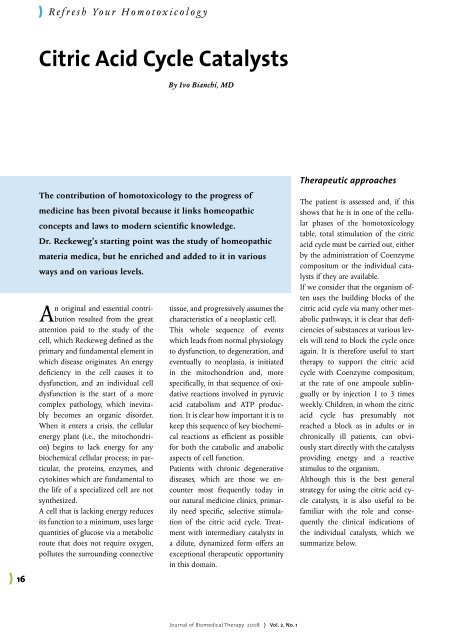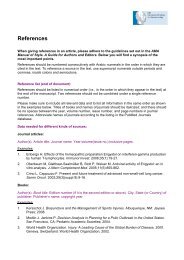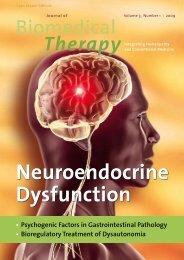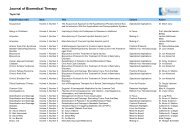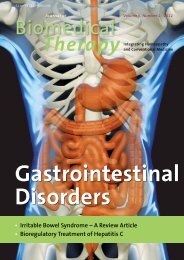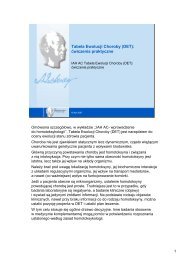Metabolic Syndrome - International Academy of Homotoxicology
Metabolic Syndrome - International Academy of Homotoxicology
Metabolic Syndrome - International Academy of Homotoxicology
Create successful ePaper yourself
Turn your PDF publications into a flip-book with our unique Google optimized e-Paper software.
) Refresh Your <strong>Homotoxicology</strong><br />
Citric Acid Cycle Catalysts<br />
By Ivo Bianchi, MD<br />
) 16<br />
The contribution <strong>of</strong> homotoxicology to the progress <strong>of</strong><br />
medicine has been pivotal because it links homeopathic<br />
concepts and laws to modern scientific knowledge.<br />
Dr. Reckeweg’s starting point was the study <strong>of</strong> homeopathic<br />
materia medica, but he enriched and added to it in various<br />
ways and on various levels.<br />
An original and essential contribution<br />
resulted from the great<br />
attention paid to the study <strong>of</strong> the<br />
cell, which Reckeweg defined as the<br />
primary and fundamental element in<br />
which disease originates. An energy<br />
deficiency in the cell causes it to<br />
dysfunction, and an individual cell<br />
dysfunction is the start <strong>of</strong> a more<br />
complex pathology, which inevitably<br />
becomes an organic disorder.<br />
When it enters a crisis, the cellular<br />
energy plant (i.e., the mitochondrion)<br />
begins to lack energy for any<br />
biochemical cellular process; in particular,<br />
the proteins, enzymes, and<br />
cytokines which are fundamental to<br />
the life <strong>of</strong> a specialized cell are not<br />
synthesized.<br />
A cell that is lacking energy reduces<br />
its function to a minimum, uses large<br />
quantities <strong>of</strong> glucose via a metabolic<br />
route that does not require oxygen,<br />
pollutes the surrounding connective<br />
tissue, and progressively assumes the<br />
characteristics <strong>of</strong> a neoplastic cell.<br />
This whole sequence <strong>of</strong> events<br />
which leads from normal physiology<br />
to dysfunction, to degeneration, and<br />
eventually to neoplasia, is initiated<br />
in the mitochondrion and, more<br />
specifically, in that sequence <strong>of</strong> oxidative<br />
reactions involved in pyruvic<br />
acid catabolism and ATP production.<br />
It is clear how important it is to<br />
keep this sequence <strong>of</strong> key biochemical<br />
reactions as efficient as possible<br />
for both the catabolic and anabolic<br />
aspects <strong>of</strong> cell function.<br />
Patients with chronic degenerative<br />
diseases, which are those we encounter<br />
most frequently today in<br />
our natural medicine clinics, primarily<br />
need specific, selective stimulation<br />
<strong>of</strong> the citric acid cycle. Treatment<br />
with intermediary catalysts in<br />
a dilute, dynamized form <strong>of</strong>fers an<br />
exceptional therapeutic opportunity<br />
in this domain.<br />
Therapeutic approaches<br />
The patient is assessed and, if this<br />
shows that he is in one <strong>of</strong> the cellular<br />
phases <strong>of</strong> the homotoxicology<br />
table, total stimulation <strong>of</strong> the citric<br />
acid cycle must be carried out, either<br />
by the administration <strong>of</strong> Coenzyme<br />
compositum or the individual catalysts<br />
if they are available.<br />
If we consider that the organism <strong>of</strong>ten<br />
uses the building blocks <strong>of</strong> the<br />
citric acid cycle via many other metabolic<br />
pathways, it is clear that deficiencies<br />
<strong>of</strong> substances at various levels<br />
will tend to block the cycle once<br />
again. It is therefore useful to start<br />
therapy to support the citric acid<br />
cycle with Coenzyme compositum,<br />
at the rate <strong>of</strong> one ampoule sublingually<br />
or by injection 1 to 3 times<br />
weekly. Children, in whom the citric<br />
acid cycle has presumably not<br />
reached a block as in adults or in<br />
chronically ill patients, can obviously<br />
start directly with the catalysts<br />
providing energy and a reactive<br />
stimulus to the organism.<br />
Although this is the best general<br />
strategy for using the citric acid cycle<br />
catalysts, it is also useful to be<br />
familiar with the role and consequently<br />
the clinical indications <strong>of</strong><br />
the individual catalysts, which we<br />
summarize below.<br />
Journal <strong>of</strong> Biomedical Therapy 2008 ) Vol. 2, No. 1


